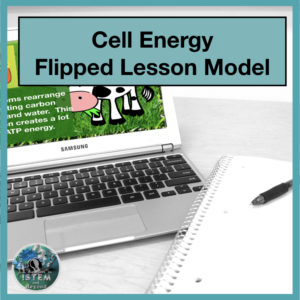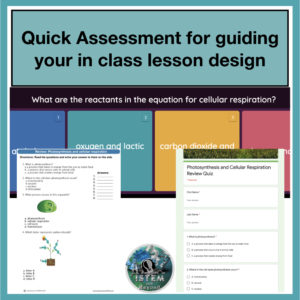Using videos as a way to teach instruction is nothing new. Teachers have been teaching students through videos for a long time. With new technology and more students having access to technology at home, now is the perfect time to start using videos in a more engaging way and not just a filler for time. There is a movement that was started around 2011-2012 called flipped learning which uses the flipped classroom model. The idea is that students learn the information on their own time and at their own pace through watching a video and class time is spent now on reinforcing and applying the concept. I jumped on board this movement around 2014 and have found great success with it. Here’s what a lesson on cell energy could look like through the lenses of flipped learning.
Using the flipped classroom model: Assigning the Video and taking notes
The first part of the flipped classroom model is to have students watch a video and take notes from it. The video could be something you created or something someone else did that you found online. If you are creating your own you can use programs like Screencast-o-matic, Camtasia, and Screencastify. If you are using a mac you could record your slideshow or use QuickTime. Once you have your video you will want to host it somewhere so that students can view it. If you are using Google Classroom you could post the video as an assignment. You could also host it on the site Edpuzzle which would then allow you to embed questions and comments into your video. (Note: Edpuzzle will integrate with Google classroom and together they make a great team) You could also host your video on your own Youtube channel. The main idea is that the video is done on the student’s own time, outside of the classroom usually, and at the student’s own pace. Below is an example of a video I created using keynote and Screencast-o-matic.
Using the flipped classroom model: Quick assessment
Using formative assessments to guide your instruction is helpful in making sure students are getting the support they need. After students watch the video and take notes they should do some sort of assessment to check their understanding of the topic and to give you an idea of which students are ready to start applying the information and which students need some extra support in learning it. You can do a simple ticket-in-the-door if you want them to be able to answer a quick question. You could have the first 5 minutes in class be designed for them to do a quick quiz. I like to host my quick assessments online where I am given analytics of the results. I love using Schoology as my LMS and so I host my quick quizzes there. You could also use a Google Form to get the information and have the form grade it for you. The website Quizizz is another great tool to use. Just make sure they use their full name when they sign in or push it out through Google classroom. The idea is that you have a quick way of knowing which students are ready to apply their knowledge of cell energy and which students will need extra support from you to help them understand cell energy. It also lets the students know where they are at in their journey in understanding the information.
Using the flipped classroom model: Differentiating the class lesson the day after
This is probably my favorite part of doing the flipped classroom method. It allows for more engaging activities in the classroom. For my students that didn’t seem to grasp photosynthesis, cellular respiration, and how they are related I would put them in a group together. I would then guide them through a simple one to two-page reading. If you have two pages then most of the pages should be taken up with a diagram. The idea is to use simply to understand text since these are usually our struggling students and they will need more visuals and simple wording. I would then have them discuss the information with the group and take notes. Finally, they would fill in a worksheet that has them review the basic ideas of the text. For my students that seem to get the basic ideas of photosynthesis, cellular respiration, and how they are related I would have them work in pairs or in groups on application activity. For this particular topic, I would have them do an online photosynthesis lab to reinforce the concept of how photosynthesis works.
Setting up a flipped lesson does take some time. However, once you have it you can use it over and over again every year. If you would like to save yourself the time you can find my lesson for teaching cell energy using the flipped lesson model by clicking HERE. Have a great time flipping your class and let me know how it goes in the comments below.
For more information on how to flip your class check out a previous blog post, I did on Flipping your classroom using the acronym FIRE.


